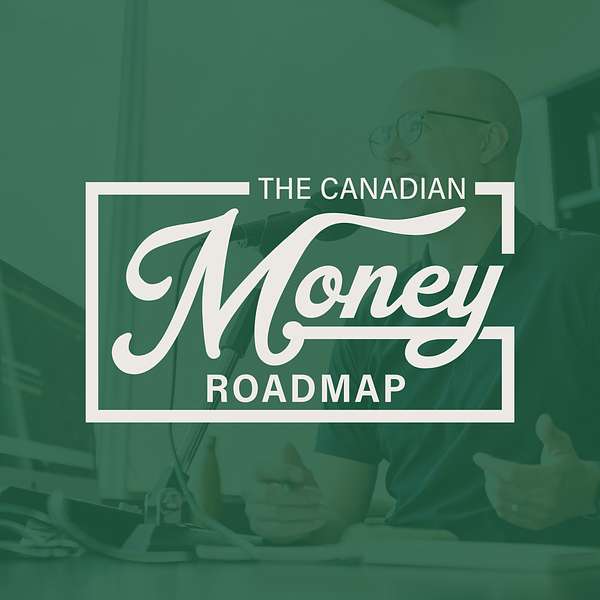
The Canadian Money Roadmap
Invest smarter, master your money, live & give more
The Canadian Money Roadmap
What happens to your RRSP after retirement?
In this week's episode we walk through the two phases of your RRSP: accumulation (RRSP) and spending (RRIF).
🌳 Connect with Evan and Cedar Point Wealth | Services and Pricing
🗣️ I want to hear from you! Record your comment or question here and you could be featured on an upcoming episode of the podcast
✨ Get your money organized - Your Full Financial Picture Spreadsheet
Hello and welcome back to the Canadian Money World Map Podcast. I'm your host, evan Newfield. On today's episode, I'm going to be walking you through what actually happens to your RRSP, your registered retirement savings plan, when you get to retirement. You've worked hard, you've saved a lot of money. Your RRSP is the thing that you've built up over the last number of decades, probably, and now the time has come for you to put in your notice and actually retire. So what happens to these retirement accounts, the RRSP specifically, when you retire? Well, quick answer nothing. Thank you for listening and we'll see you next week. No, nothing actually happens to your RRSP right away when you retire, because retiring is not some sort of formal designation that happens as far as taxes go or anything like that. Retirement is your choice and your prerogative to go back to work at any time if you'd like. So your decision to stop work or go back to work or anything like that is largely irrelevant in terms of any of your government benefits or your retirement savings plans. So let's break this down in terms of what you might choose to do. So, once you retire, for most people you're likely going to need to start withdrawing from your investments because you've got to live on something. Government benefits usually aren't enough and maybe if you're retiring before age 60, for example, you might need to live off of your own savings before you even become eligible to receive government benefits like CPP and old age security. So if you have an RRSP and you need to start withdrawing from it, you can. I recorded a video on YouTube recently about the ins and outs of withdrawing from your RRSP before retirement, but in this episode of the podcast we're going to talk about those things in retirement.
Speaker 1:You can think of an RRSP as having two distinct phases. The first one is the accumulation phase and the second one is the decumulation or the income phase. So the accumulation, so the growing and the saving and the investing phase is the RRSP, so that's the registered retirement savings plan, so it's in the name there. And then the second phase is the RIF, that's an RRIF Registered Retirement Income Fund and these are both just account types. And again, account types are buckets. They are not investments in and of themselves. They are things that you can put investments in. So, as far as investments go, you don't have to make any changes to your investment strategy or your holdings or anything like that. It's just a different bucket, because your RRIF is now a bucket with a hole in it and the hole just implies that you need to take some money out of that account every single year. There are minimums that get set based on your age and your account size and I'm going to get to that in a second. But those are the two distinct phases of your RRSP. Again, the accumulation phase is the RRSP, the decumulation of the income phase is the RIF.
Speaker 1:Now, like I said before, you don't have to do anything when you retire, because retirement is not any sort of official status. But at some point the government actually says well, you got to do something with this and you got to start taking that money out. So the very, very latest that you can still maintain an RRSP is the year that you turn 71. So your RRSP has to be converted to a RIF at some point during the year that you turn 71. It can be January 1, it could be December 31 or anywhere in between, but it has to be converted to a RIF at that point, prior to age 71, you can convert a portion to a RIF. If you want, you can convert all of it to a RIF. You can do that at any point that you want, but age 71 is the latest that you can stretch it out. So let's talk about those minimums a little bit more.
Speaker 1:So again, now that you've converted your RRSP to a RIF and you have to start taking some money out, how much do you actually have to take out? Well, there are percentages based on your age and the account value at the end of the year. So the thing to keep in mind is that there is no minimum required in the initial year that you convert to a RIF. You have to take out a minimum amount the following year. So let's back up again and talk about, like the latest that you could withdraw. So if you convert your RRSP to a RIF at age 71, you only have to take a minimum amount in the year that you turn 72. So you can really stretch this out for almost a full calendar year because you can withdraw the minimum amount all at once or stretched out monthly, or however you want to do it. But if you really want to put it off, you can take an annual payment at the end of December of your age 72 year. So, anyways, you can get kind of cute with that if you really want to.
Speaker 1:But the vast majority of people that are converting their RRSP to RIFs are doing it because they actually need some money to live on. So how much do you actually have to take out? So if you convert your RRSP to a RIF at age 65, the minimum amount is a nice round number of 4%. So if the account balance at the end of the previous calendar year was a million bucks and you turn 65, you have to take out $40,000 at some point during the next year. Now, if you're 66, that percentage jumps up to 4.17 and 4.35. I'm not going to read all of this, but age 70, it's at 5%, and age 80, it gets up to 6.82%, age 90, it's 11.92%, and then age 95 and older, it's 20% per year. So for people that are wanting to just withdraw enough to live on or whatever, you might actually be forced to withdraw more than you really want. And so this is where a solid retirement income strategy might come in, because your minimum amounts might be far more than you need or they might not be enough, which is totally fine, because a RIF again is a bucket with a hole in it, but there's no lid on the top, so you can take out as much as you want, but these percentages are the amounts that you have to withdraw.
Speaker 1:Now, big thing to keep in mind with RRSP withdrawals and RIF withdrawals is that every dollar that comes out of both of these account types counts as regular income for tax purposes, meaning every dollar is taxable, and our tax system works based on the fact of the more income you have, the more tax you pay. But you also have the opportunity to have deductions and tax credits. So for me to say how much tax you're going to owe is impossible, because your situation is entirely unique. But all of the money that comes out of your RIF is all included in your regular income and is subject to taxes. Before you get to that point, however, the government's going to take theirs a little bit too.
Speaker 1:So when you make a withdrawal from a RIF, your withdrawal might be subject to something called withholding tax. Withholding tax is not an additional tax, it's not a penalty. It is money that you're prepaying to the government based on the fact that you're likely to owe some taxes on that money, because it's all taxable. The rates of withholding tax are 10% on a withdrawal of 5,000 or less, 20% on 5 to 15,000, and 30% on amounts over $15,000. Most financial institutions do this on an annualized basis, not on an individual withdrawal basis. So there's no opportunity to game the system on having a lower withholding tax amount by doing smaller withdrawals more often. I know people that have gotten trouble by trying to do that, so don't do that. But the thing you'll have to keep in mind here is that with an RRSP, if you withdraw money from an RRSP, every dollar is subject to withholding taxes. But if you withdraw from a RIF, withholding taxes are only applicable on amounts over the minimum. That doesn't mean they are exempt from taxes. It just means you don't have to prepay income tax on it.
Speaker 1:Let's do an example here. So say you're a 65 and that minimum is 4%. If you actually withdraw something closer to 6%, you would have to pay withholding taxes on the additional 2% that you're withdrawing from the account. Again, all 6% of the total withdrawal is taxable income, but you only have to prepay taxes on amounts over the minimum. So this is where I've seen many people get in trouble. If they have really large RIF accounts and they're only taking the minimums out, and if their minimum again is, say, $40,000, say, oh boy, I can probably just live on $40,000. Nope, because that that is taxable, and in every province. $40,000, again, just hypothetical here would attract taxes. There's not enough exemptions to be able to qualify for $40,000 of income to be tax free, unless you have a pile of deductions or credits or something like that. So, anyways, this is where people can run into trouble because of the withholding taxes. Lots of people dislike paying withholding taxes, but it usually keeps people out of trouble because there's nothing people hate more than having to come up with money after they file their taxes and pay more taxes than they thought. Again, it's not a penalty, it's just something you have to be aware of so that you can properly calculate how much taxes you're going to owe.
Speaker 1:Now, going back to RIF withdrawals here last week on the podcast I talked about income splitting and the cool thing with RIF income is that if you convert your RSP to a RIF and you're 65 or older, you can split up to 50% of your income with your spouse or common law partner. This can really really help the vast majority of people reduce their lifetime tax bill, unless there's a situation where you and your spouse aren't exactly the same amount of money you saved exactly the same amount of money. This almost never happens, and so there's some great opportunities to plan for building RSP assets and then converting them to RIFs and saving a bunch of taxes on the way out. So some final things to keep in mind here. Just like an RSP, a RIF can have a name beneficiary on it. If you have a spouse, I would recommend you name your spouse as the beneficiary of your plan. That way you'd be able to take advantage of the tax-free rollover provisions. If you were to pass away, you're supposed to be able to take over your RIF and maintain that account in their name without taxes showing up in between.
Speaker 1:Another thing to keep in mind is that your income that comes out of a RIF whether it's the minimum amount or any additional withdrawals, because it's all taxable it can be enough to reduce your old age security benefits. So old age security is a government pension that is provided to people below a certain income threshold. It changes every year with inflation, and so I won't talk about the exact dollar amounts right now, but it's pretty generous. But I have seen it where people need to make significant withdrawals from their RIF to do, say, a renovation, or they need a new car or something like that, and then they have so much income in that year that they end up losing some or all of their old age security benefits for the following year as well. So that's something you just really want to be careful of when you're making withdrawals from your RIF. This is why I always advocate for people having multiple sources of income in retirement. Broadly speaking, that would be including the tax-free savings account as well, because anybody that you take out of your TFSA is not taxable. It does not affect OAS or any other income-tested benefits.
Speaker 1:Having a TFSA in retirement creates so much flexibility. It'll allow you to more comfortably live the way that you want and be able to adapt to the situations that present themselves, whether that's fun things or emergency type things. Having some tax-free sources of income that you can access at your discretion is incredibly valuable. So let me give one more example of how that withholding tax situation might work and how you might end up with more gross income than you really think. So say, for example, you have a million bucks in a RIF and then by the time you retire, say, you're age 65, you need to take your 4% minimum amount, that plus CPP, that plus OAS whatever your spouse has. That might be enough for you, but, uh-oh, car breaks down. You need to get a new vehicle. Vehicles are outrageously expensive these days. You need to actually come up with $50,000 for a big expense or renovation or whatever helping your kids with a wedding Also.
Speaker 1:I see all sorts of things all the time. If you want to take $50,000 out of your RIF, you actually have to withdraw $71,428 because that's the gross amount required to offset the withholding taxes. So if you take $71,428 times.3 to get your 30% withholding tax, you end up with a net amount of $50,000. So that withholding tax amount in this case it might be too much, it might be not enough and if it is too much, when you end up filing your taxes the following year, you will get a refund, dollar for dollar, of the taxes that you paid that were over the amount that you actually were required to. So your T4 RIF at the end of the year will have the gross amount that you withdrew plus the withholding taxes that you've already paid, so that you do get credit for all of that. But then the opposite could happen as well. Say, you've only paid 30%, but your marginal rate might be 35, you might actually end up owing some money. So, even though there are withholding taxes, that is not the end of the story, unfortunately.
Speaker 1:When you have RIF income, those are the things you have to keep in mind when you're taking money out. So quick summary here there are two phases to the RSP. The first one is the accumulation phase as the savings plan registered retirement savings plan and then, once you want to start taking money out of it, I recommend that you do that from a RIF and you convert that to a RIF whenever you want, but at the very latest at the end of the year that you turn 71. At that point you have to start making minimum with trolls, and those are dollar amounts set at the beginning of the year based on what your account value was at the end of last year, times a percentage based on your age. That percentage goes up every year. Your account value may fluctuate so depending on how it's invested, it might go up, it might go down, and so your minimums will vary from year to year because the percentage will change and the dollar amounts at the end of the previous year will also change. When you make a withdrawal from a RIF, there are no withholding taxes required on the minimum amount, but there are taxes owing on that amount, because every dollar that you take out of a RIF is taxable income. You can split it With your spouse. If you're over the age of 65, you can split 50% of it, so that can really help, but every dollar that comes out of this account is included in your income in that year. So, anyways, this is what happens to your RSP when you retire.
Speaker 1:Retiring is not a formal designation or anything like that, but this is just something that you have to elect to do to start turning the taps on your own savings and investment, to start living off it. This can be really challenging for people just mentally to actually do that. Because you live a certain way and build up your savings and investments over a long period of time, it becomes very challenging for people to actually flip the switch from saving to spending. So having a good plan for that stage of life is critical. So you know the implications from a tax perspective and a longevity perspective, as you have a good idea of what could happen with your investments. Having a plan really gives people a lot of confidence.
Speaker 1:If you are looking for a retirement income plan, that's something that our team specializes in feel free to shoot us an email or check out my website at evanewfieldcom and see if someone from our team can build a plan for you and your retirement income stream. Thank you so much for listening to this episode and we'll see you next week. Thanks for listening to this episode of the Canadian Money Roadmap Podcast. Any rates of return or investments discussed are historical or hypothetical and are intended to be used for educational purposes only. You should always consult with your financial, legal and tax advisors before making changes to your financial plan. Evan Neufeld is a certified financial planner and registered investment fund advisor. Mutual funds and ETFs are provided by Sterling Mutuals Inc.
Podcasts we love
Check out these other fine podcasts recommended by us, not an algorithm.

The Rational Reminder Podcast
Benjamin Felix, Cameron Passmore, and Dan Bortolotti
Animal Spirits Podcast
The Compound
The Intelligence from The Economist
The Economist
The Compound and Friends
The Compound
Trillions
Bloomberg
The Journal.
The Wall Street Journal & Spotify Studios
Standard Deviations with Dr. Daniel Crosby
Dr. Daniel Crosby
